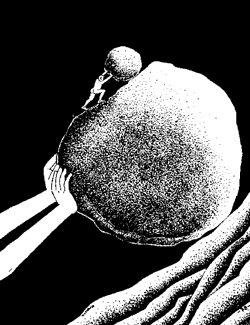 The Indian news media's coverage of Nepal gets nauseating with each episode. The crescendo of criticism that nobody on the other side of the border seems to care about should not allow us to wallow in self-pity. It's time to try another tack. Let's shut our eyes and plug our ears for some critical contemplation.
The Indian news media's coverage of Nepal gets nauseating with each episode. The crescendo of criticism that nobody on the other side of the border seems to care about should not allow us to wallow in self-pity. It's time to try another tack. Let's shut our eyes and plug our ears for some critical contemplation. Satellite TV and the Internet may have expanded the reach of what Indian reporters file, but their responsibility essentially remains what it has always been: advancing their nation's agenda. Regardless of how rapidly their international audience grows, their primary duty is to resident Indians.
Once that premise is perceptible, it becomes easier to get some perspective. As long the as panchas enjoyed official Indian confidence as the custodians of the yam that could maintain a semblance of equilibrium between the two Asian boulders, Indian newspapers didn't think Nepali politics was terribly newsy. But they did maintain correspondents and stringers just in case. If the partyless community tried to play its cards a little too cleverly, the editors back home knew they could always get instant copy on how elections were rigged or how restive the people were getting over the profligacy of their rulers. The more discerning readers on both sides of the border understood all along that it really wasn't that Panchayati Nepal contained no news value; it's just that it didn't fit into official Indian policy.
When Nepal needed some anti-aircraft guns through the trans-Himalayan route at a time when its trade and transit treaty with India was about to expire in the late 1980s, the ground rules in Indian newsrooms saw a transition. The panchas suddenly turned out to be tyrants, a story line buttressed by the debris of the Berlin Wall. In no time, the Indian media started covering how Nepalis were dying for democracy. There were no liberal or hard-line panchas anymore. Those who had chosen to become part of the contemptible system had to be rotten to the core.
A similar paroxysm of episodic allurement had consumed Indian reporters and editors of an earlier generation. What was remarkable in their coverage of events leading up to the 1951 political changes in Nepal is the prominence the country had acquired in both the news and op-ed pages. Koirala was already a headline name then, although it was Matrika Prasad who you'd invariably come across in the lead graph.
Re-reading those yellowing pages, you'd think the revolutionaries who had denounced the "Delhi compromise" as a betrayal of the cause were congenitally uncompromising miscreants bent on spoiling the party. Meanwhile, rookies who started out in newsrooms down south with copy on the fall of Birgunj went on to write books like Delhi Accosts Peking in Kathmandu.
The purpose of this ponderous overview is to emphasise that on foreign policy and defence matters, the Indian media uniformly projects the official line. That's why you probably wouldn't know that Pakistan-occupied Kashmir is known on the other side of the Line of Control as Azad Kashmir, complete with its own president and prime minister. You miss that vital regional reality in that Bangladeshis don't feel they have to thank Indira Gandhi for their independence because they knew from the outset that she was just trying to get even with General Yahya Khan. Moreover, you would tend to believe the Bhutanese are simply thrilled by the opportunity of being able to subcontract their foreign and security policies all these years.
It would be unfair, however, to single out the Indian media for failing to depart from the government agenda. Remember how The New York Times held back its exclusive on the impending Bay of Pigs invasion in 1961 on the Kennedy White House's explicit orders? Or, more recently, how the US TV networks deferred to the Bushies who wanted Osama bin Laden off America's air waves?
Our anger at having to see in the Indian media a Nepal that scarcely resembles the one we live in is exacerbated by our inability to do much about it. We can't expect the government to ban Indian newspapers, jam Indian TV channels or order our ISPs to build firewalls to keep out Indian websites carrying inflammatory content. A little extra shot of scepticism could be helpful, though. The next time you read external analyses on who might stand to benefit from a Maoist insurgency that began in the midwestern Nepali hills, think about the foreign military checkposts that were ordered out by Kirtinidhi Bista's government in the late 1960s. If you're flustered by why so many Indian governments are interested, remember this: the power that comes with space-linked surveillance, intelligence and navigation systems on Nepal's high mountains gets geo-strategic leverage over several Asian regions, from Central Asia to South East Asia. What this means is, if you can't get to place your own listening posts on the Everest range, the second best thing would be to make sure no other country does. Conspiracy theorists may be a calumniated lot, but they're the ones who widen the range of possibilities so that others can narrow down their search.
If you still can't figure out how that TV reporter boarding his flight back to New Delhi with his hidden camera turned on could hand in that story on Tribhuvan International Airport's lax security or how that garrulous Nepali passenger on IC Flight 814 could end up being described as one of the hijackers, consider this: it's not without reason that the press is called the fourth estate of the state it represents.


